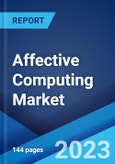The global affective computing market size reached US$ 51.1 Billion in 2022. Looking forward, the publisher expects the market to reach US$ 298.7 Billion by 2028, exhibiting a growth rate (CAGR) of 34.2% during 2022-2028.
Also known as emotion AI, affective computing is a combination of cognitive science, psychology, and computer science that senses the non-verbal emotional signals of human beings. It analyzes the emotion of a person by using an analytics engine, big data, machine intelligence, and different sensors. It assists businesses in enhancing the overall user experience and selling products effectively. As a result, affective computing finds extensive application in autonomous and e-learning systems across the globe.
2. What is the expected growth rate of the global affective computing market during 2023-2028?
3. What are the key factors driving the global affective computing market?
4. What has been the impact of COVID-19 on the global affective computing market?
5. What is the breakup of the global affective computing market based on the technology?
6. What is the breakup of the global affective computing market based on the components?
7. What is the breakup of the global affective computing market based on the end use?
8. What are the key regions in the global affective computing market?
9. Who are the key players/companies in the global affective computing market?
Also known as emotion AI, affective computing is a combination of cognitive science, psychology, and computer science that senses the non-verbal emotional signals of human beings. It analyzes the emotion of a person by using an analytics engine, big data, machine intelligence, and different sensors. It assists businesses in enhancing the overall user experience and selling products effectively. As a result, affective computing finds extensive application in autonomous and e-learning systems across the globe.
Affective Computing Market Trends:
Affecting computing helps establish an interaction between a computer and a human being by detecting the stimuli of the user and responding accordingly. The technology relies on high-speed broadband connections to ensure real-time and effective communication between high-resolution dual cameras and the machine learning (ML) models that interpret human emotions. Therefore, the numerous benefits offered by affective computing represent one of the significant factors positively influencing its application in several end use industries around the world. Besides this, it can be employed for personalization, such as changing room temperature, music, and lighting as per the requirement of the user, which is contributing to the market growth. Furthermore, the rising adoption of AI in logistics, parking aid software, autonomous cars and surgical robots is bolstering the growth in the market. Apart from this, the growing deployment of robots, rising utilization of wearable devices, and increasing collaborations among market players are anticipated to catalyze the demand for affective computing across the world.Key Market Segmentation:
The publisher provides an analysis of the key trends in each sub-segment of the global affective computing market report, along with forecasts at the global, regional and country level from 2023-2028. Our report has categorized the market based on technology, components and end use.Breakup by Technology:
- Touch-based
- Touchless
Breakup by Components:
- Hardware
- Sensors
- Cameras
- Storage Devices and Processors
- Others
- Software
- Analytics Software
- Enterprise Software
- Facial Recognition
- Gesture Recognition
- Speech Recognition
Breakup by End Use:
- Automotive
- BFSI
- Government
- Healthcare
- IT and Telecom
- Others
Breakup by Region:
- North America
- United States
- Canada
- Asia-Pacific
- China
- Japan
- India
- South Korea
- Australia
- Indonesia
- Others
- Europe
- Germany
- France
- United Kingdom
- Italy
- Spain
- Russia
- Others
- Latin America
- Brazil
- Mexico
- Others
- Middle East and Africa
Competitive Landscape:
- The competitive landscape of the industry has also been examined along with the profiles of the key players being Affectiva Inc., Cipia Vision Ltd., Cognitec Systems GmbH, Elliptic Laboratories A/S, Google LLC (Alphabet Inc.), Intel Corporation, International Business Machines Corporation, Kairos AR Inc., Microsoft Corporation and Nuance Communications Inc.
Key Questions Answered in This Report
1. How big is the global affective computing market?2. What is the expected growth rate of the global affective computing market during 2023-2028?
3. What are the key factors driving the global affective computing market?
4. What has been the impact of COVID-19 on the global affective computing market?
5. What is the breakup of the global affective computing market based on the technology?
6. What is the breakup of the global affective computing market based on the components?
7. What is the breakup of the global affective computing market based on the end use?
8. What are the key regions in the global affective computing market?
9. Who are the key players/companies in the global affective computing market?
Table of Contents
1 Preface3 Executive Summary11 Value Chain Analysis13 Price Analysis
2 Scope and Methodology
4 Introduction
5 Global Affective Computing Market
6 Market Breakup by Technology
7 Market Breakup by Components
8 Market Breakup by End Use
9 Market Breakup by Region
10 SWOT Analysis
12 Porters Five Forces Analysis
14 Competitive Landscape
List of Figures
List of Tables
Companies Mentioned
- Affectiva Inc.
- Cipia Vision Ltd.
- Cognitec Systems GmbH
- Elliptic Laboratories A/S
- Google LLC (Alphabet Inc.)
- Intel Corporation
- International Business Machines Corporation
- Kairos AR Inc.
- Microsoft Corporation and Nuance Communications Inc.
Methodology

LOADING...








